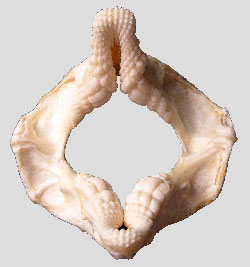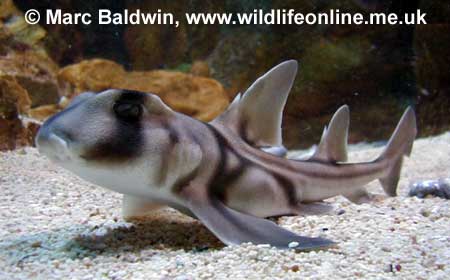Intertidal Zone: Life Between the Tides
Port Jackson Shark
To a very large extent, a shark’s dentition dictates its feeding habits, and the Port Jackson Shark (Heterodontus portusjacksoni) is subject to this rule, too. However, like its fellow members of the family Heterodontidae (“different teeth”), the rear teeth of the Port Jackson Shark change form dramatically as the animal grows. The teeth of juveniles of this species are all more-or-less alike. But by the time Port Jackson Sharks are mature, their rear teeth have become elongated and molar-like.
Just the Facts:
Size:
Reproduction:
Diet:
Habitat: Intertidal, Sandy Plains, Rocky Reefs, Kelp Forests Depth: Intertidal to 565 ft (172 m) Distribution: Western Australian, Southeast Australian/New Zealand, Northern Australian |
The functional significance of this change in rear tooth form is fascinating. The delicate, multi-cusped dentition of juvenile Port Jackson Sharks is well suited to grasping the soft-bodied burrowing prey on which they feed. Buried prey is often excavated by pumping water and sediment through the mouth and out the muscular gills, generating great clouds of silt in the process. The molar-like rear teeth of adult Port Jackson Sharks are concentrated near the jaw corners, where the powerful jaw-closing muscles are located. As a result, these flattened rear teeth are brutally efficient crushing plates, resembling a kind of piscine nutcracker.

This dental arrangement enables adult Port Jackson Sharks to tackle even the toughest of hard-shelled prey. Due to its specialized dentition and ability to tolerate wide changes in salinity, the Port Jackson Shark often haunts the intertidal zone at high tide. There it uses its multi-cusped front teeth to grasp almost any intertidal creature it finds and grinds them up using its molar-like rear teeth. Unfortunately for Australian aquaculturists, the Port Jackson does not differentiate between wild bivalves and commercial mussel and oyster beds. Indeed, Port Jackson Sharks seem to regard these carefully maintained, hanging structures as a kind of free underwater smorgasbord of which they are obligated to take full advantage. This costly opportunism has earned Port Jackson Sharks a vile reputation among commercial shellfish farmers, who know them by the hated name, “oyster crusher”.
It’s probably a good thing for the species that Port Jackson Sharks move around quite a lot. Extensive tagging studies off southeastern Australia have demonstrated that Port Jacksons are highly migratory and have a phenomenal homing ability. Evidence from tag returns demonstrate that these sharks annually travel huge distances (up to 530 miles or 850 kilometres) along the Australian coast, returning year-after-year to specific bays which are used as mating and egg-laying grounds. The sharks also use specific resting sites in and around Sydney Harbor. Researchers have found that, when transferred by boat to different parts of the Harbor as much as 1.5 miles (3 kilometres) away, Port Jackson Sharks unerringly navigate back to their original resting sites. Based on many years of such studies, it now seems clear that Port Jacksons must have a well-developed spatial memory, moving through their liquid realm with the aid of highly detailed ‘mental maps’.
Such mental maps play a vital role in Port Jackson Shark reproduction. Every two years, from August until early October, adult female Port Jacksons return to traditional inshore egg-laying sites. Two auger-shaped egg cases are laid at a time. When the egg cases are first laid, they are amber in color, soft and pliable. One by one, the mother Port Jackson gently picks-up her freshly-laid egg cases between her front teeth and swims them to a nearby rocky reef. There, she pushes them into any convenient crevice. In urban areas, Port Jackson Shark egg cases are sometimes pushed under drainage pipes or into tin cans. No matter where they are deposited, once they harden, the egg cases turn dark brown and are virtually impossible for would-be predators to remove — they must literally be unscrewed, which is a tall order for egg thieves lacking opposable thumbs.
After egg-laying, a mother Port Jackson Shark may take a year off to rebuild her energy stores. Then she will be ready to mate again. Through extensive tagging studies along southeastern Australia, it was discovered that, like many other sharks, Port Jacksons segregate by sex. Female Port Jacksons generally live in deeper water than the males. But both sexes must come together to mate, an event which often occurs in shallow intertidal areas, just inshore of the traditional egg-laying grounds. During mating, the male Port Jackson Shark typically grasps the female by one of her pectoral fins, flexes the far-side clasper across the mid-line of his body and inserts it into her genital opening.
A few quick thrusts, and the procreative act is over. Male and female part company, each going about his or her own business as though quite unmoved by the experience. However unmoved they may seem, male and female Port Jackson Sharks return to the same shallow bays year after year, responding to inner voices we shall never hear.
Port Jackson Shark Bibliography
More about : Bullhead Sharks
| Port Jackson egg placement


